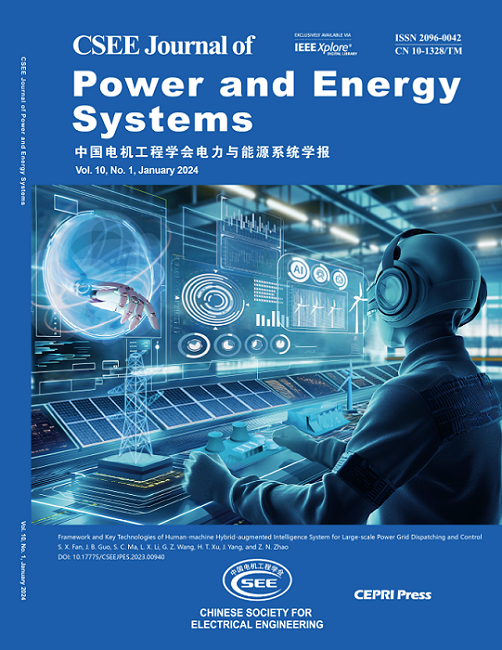Frequency-Voltage Active Support Strategy for Hybrid Wind Farms Based on Grid-Following and Grid-Forming Hierarchical Subgroup Control
IF 5.9
2区 工程技术
Q2 ENERGY & FUELS
引用次数: 0
Abstract
The GFL-GFM hybrid wind farm (HWF) combines the voltage source control advantages of grid-forming (GFM) wind turbines (WTs) with the current source control advantages of grid-following (GFL) wind turbines. It becomes a new type of large-scale grid-connected wind power generation. In this paper, we propose an HWF frequency-voltage active support based on GFL and GFM hierarchical subgroup control. It aims to realize the support of active power and reactive power under the premise of ensuring system stability. The strategy consists of the determination of the control objectives of the GFM-GFL subgroups, the distributed control (DC) of the GFM-GFL subgroups, and the adaptive control and switching of each unit of the GFM and GFL groups. The GFM-group maintains the grid-connected voltage stability and the GFL-group exhausts the active support. DC at the group level and adaptive control at the unit level are included under the hierarchy of the respective objectives. Finally, a GFL-GFM HWF model is established on the MATLAB/Simulink platform, and the simulation verifies that the proposed strategy can realize the enhancement of the frequency-voltage support capability of the HWF under the premise of grid-connected stability.基于电网跟随和成网分层子群控制的混合风电场频率电压主动支持策略
GFL-GFM混合风电场(HWF)结合了电网形成(GFM)风力涡轮机(WTs)的电压源控制优势和电网跟随(GFL)风力涡轮机的电流源控制优势。成为一种新型的大型并网风力发电。本文提出了一种基于GFL和GFM分层子群控制的HWF频率电压主动支持方法。其目的是在保证系统稳定的前提下实现有功和无功的支持。该策略包括GFM-GFL子群控制目标的确定、GFM-GFL子群的分布式控制(DC)以及GFM和GFL子群各单元的自适应控制和切换。gfm组维持并网电压稳定,gfl组耗尽主动支持。在各自的目标层次结构下,包括组级的DC和单位级的自适应控制。最后,在MATLAB/Simulink平台上建立了GFL-GFM HWF模型,仿真验证了所提出的策略能够在保证并网稳定的前提下实现增强HWF的频率电压支持能力。
本文章由计算机程序翻译,如有差异,请以英文原文为准。
求助全文
约1分钟内获得全文
求助全文
来源期刊

CSEE Journal of Power and Energy Systems
Energy-Energy (all)
CiteScore
11.80
自引率
12.70%
发文量
389
审稿时长
26 weeks
期刊介绍:
The CSEE Journal of Power and Energy Systems (JPES) is an international bimonthly journal published by the Chinese Society for Electrical Engineering (CSEE) in collaboration with CEPRI (China Electric Power Research Institute) and IEEE (The Institute of Electrical and Electronics Engineers) Inc. Indexed by SCI, Scopus, INSPEC, CSAD (Chinese Science Abstracts Database), DOAJ, and ProQuest, it serves as a platform for reporting cutting-edge theories, methods, technologies, and applications shaping the development of power systems in energy transition. The journal offers authors an international platform to enhance the reach and impact of their contributions.
 求助内容:
求助内容: 应助结果提醒方式:
应助结果提醒方式:


